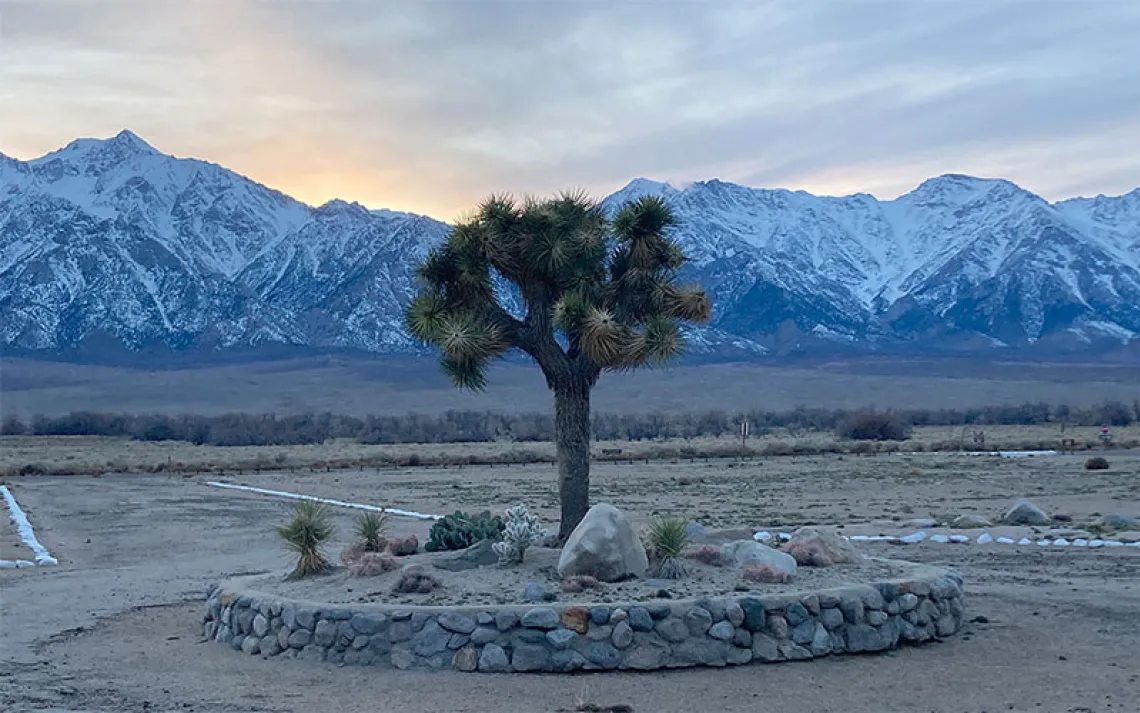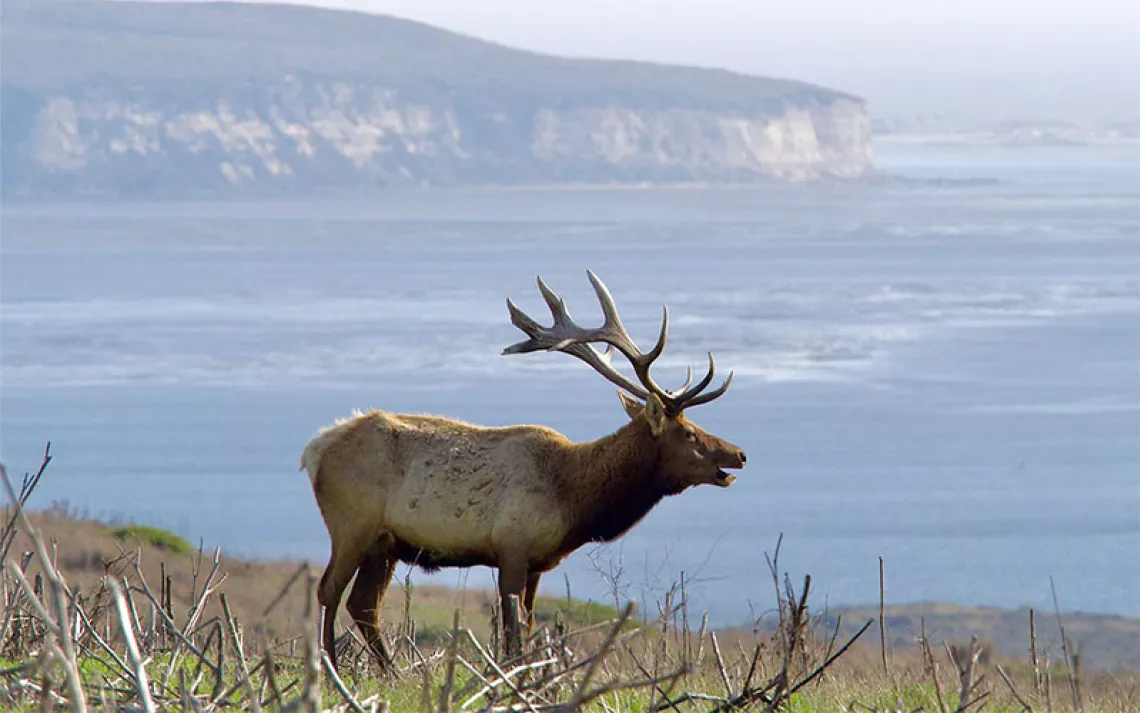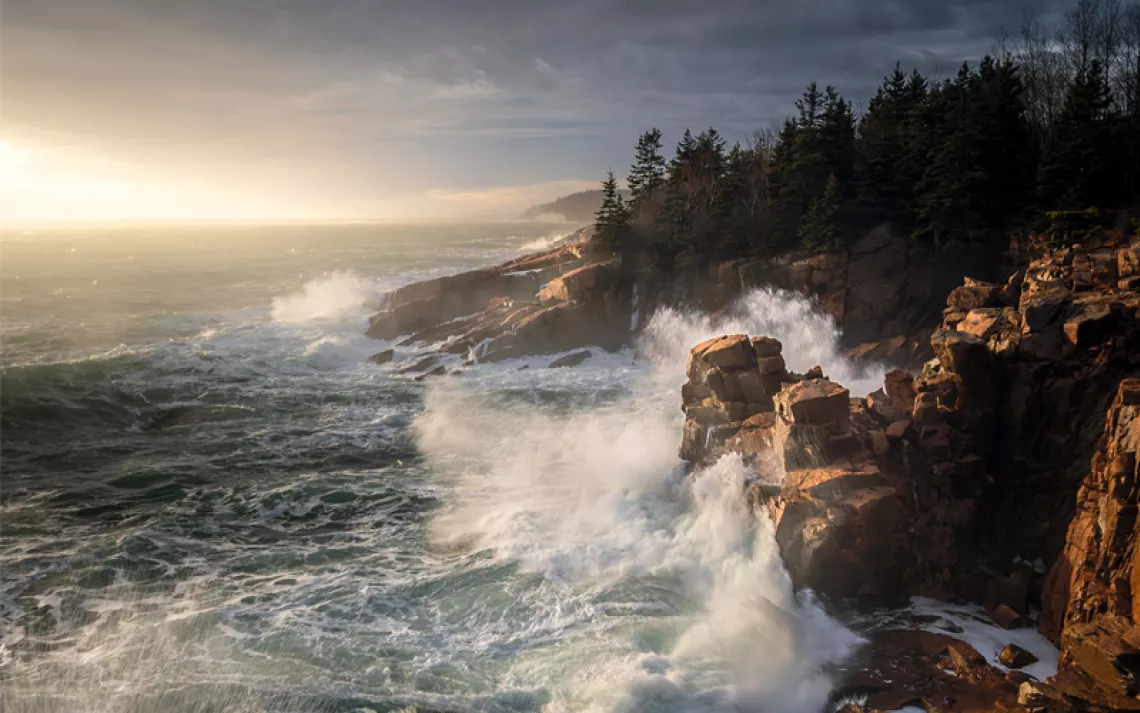On the California Coast, It’s Cattle Versus Elk
Point Reyes National Seashore is once again at the center of a heated debate

Photo courtesy of the National Park Service
Point Reyes National Seashore is once again ground zero for an emotional debate over the purpose of America’s national parks. Should the parks’ mission be to preserve wildlife or conserve history? Should they be set aside as wilderness or tended as a human landscape? How can land managers balance the not always reconcilable needs of wildlife and domesticated livestock?
In 2012, wildness won out when the National Park Service chose not to renew the lease for an oyster farm situated in an estuary long designated as “potential wilderness.” The debate leading up to that decision tore apart the tiny Northern California communities surrounding the park, as friends and neighbors were split over whether to let the oyster farm continue doing business or to remove the aquaculture operation. Signs pleading “Save Our Drakes Bay Oyster Farm” had only recently come down when, a few years ago, another debate over the future of the seashore emerged. Near the seashore’s misty headlands, a herd of free-roaming tule elk moved onto ranchland. There, the elk have barreled through range fencing, eaten livestock feed, and, according to one rancher, gored cattle. A new battle line was drawn: elk versus cows.
A little more than an hour’s drive north of San Francisco, Point Reyes is Northern California distilled: coastal mountains forested in Douglas fir catch the fog, rolling grasslands bloom with wildflowers, and white sandstone cliffs fall into the Pacific. It is also one of a small percentage of sites in the national park system that allow cattle grazing within its boundaries. In the 1960s, after a campaign led by the Sierra Club spurred the government to preserve Point Reyes, the Park Service bought the seashore piece by piece from the cattle ranchers and dairy families who lived there, under an agreement that they could rent the land they had sold and continue ranching. In the 1980s, some 33,000 acres of the seashore were designated federal wilderness. Yet the seashore’s pastoral and wilderness zones haven’t always coexisted peaceably; while some wilderness advocates say ranching is incompatible with the park’s purposes, ranchers and dairies are often inconvenienced by the challenges of ranching with the wild.
In August, the Park Service released the first draft of an updated management plan with a “preferred alternative” intended to appease both sides of the wildness vs. pastoralism and elk vs. cow debates. The proposed management plan, however, appears to have pleased no one and instead has only fueled the disagreement.
The NPS plan proposes shooting up to 15 elk each year to keep the population of the elk herd at 120, the highest number of elk Park Service ecologists say could share forage with existing cattle. David Press, a wildlife biologist for the National Park Service, said the elk can’t be transferred out of the seashore because they are infected with Johne’s Disease, an incurable wasting disease that both elk and cattle are susceptible to. (In the 1970s, scientists determined the disease likely spread to the elk from cattle.) But that idea has left some wildlife advocates fuming. Jeff Miller, a senior conservation advocate for the Center for Biological Diversity, called the plan to shoot the elk “pure insanity.”
“It’s unbelievable that we’re actually talking about killing the most iconic wildlife species in the only national park where it occurs,” he said. “We, collectively as a society, have put a ton of effort into recovering tule elk. Point Reyes represents the best opportunity to build a large herd on public land, but instead of going in that direction, the Park Service has decided that these are problem animals that need to be removed for the benefit of a handful of commercial lease holders.”
For their part, some ranchers and dairy operations and their allies feel like the plan doesn’t do enough to protect the pastoral character of the seashore and fear that the elk will continue to compete with cattle for forage and water.
“I believe the management plan has intentionally failed to support ranching families,” said Albert Straus, whose organic creamery sources milk from the historic A and B Ranches, where competition with the free-range elk is strongest.
Writing in the September 19 edition of the local weekly newspaper, Point Reyes Light, Phyllis Faber, a cofounder of the Marin Agricultural Land Trust and a staunch ranching defender, was also dissatisfied. “The document is deceptive,” she wrote. “The preferred alternative would implement new restrictions on and requirements of ranchers, add natural resource protections, force ranchers to accept competition with elk, and limit allowed agricultural activities.”
Although tule elk are the smallest of the four subspecies of elk found in North America, when the first Europeans came to California, they were nonetheless baffled by them. Exploring the Northern California coast in 1579, the English privateer Sir Francis Drake described how “infinite was the company of very large and fat Deere, which there we sawe by thousands.” Biologists estimate that in 1850, there were around 500,000 tule elk in California. By the 1870s, they had been hunted to the point of extinction; less than 30 remained on a single ranch near Bakersfield.
In 1978, the Park Service moved 10 elk from the San Luis National Wildlife Refuge, in California’s Central Valley, to a 2,600-acre fenced “reserve” on Tomales Point, the seashore’s northernmost tip. The herd grew fast. Within 10 years, it had a population of 93. By 1997, it had more than quadrupled. Today, the Tomales Point herd (which isn’t included in the Park Service’s preferred alternative of the proposed management plan) has a population of around 430.
In 1998, in response to concerns over the herd’s increasing population, the National Park Service established a free-roaming herd by moving 28 elk to a wilderness area in the southern portion of the seashore. It set the herd’s population limit at 350—not the number of elk the landscape could sustain but the number of elk the Park Service felt could be “successfully maintained, monitored, studied, and as necessary, controlled.”
Then, in a scenario the seashore’s biologists never contemplated, several elk swam across the estuary that separates the wilderness area from a handful of historic ranches and established a new herd. Today, that group of animals—called the Drakes Beach herd, after the area where it landed—has increased to 124 elk. That number means that, under the proposed management plan, Park Service staff would have to shoot and kill at least four animals.
Amy Meyer, who worked on a citizen’s advisory commission that supervised management decisions at Point Reyes for the entire 29 years it was in effect, said that compared with the management of wildlife in other national parks, the proposal to shoot up to 15 elk a year is almost modest. In 2016, wildlife managers and eight “skilled volunteers” at Wind Cave National Park in South Dakota shot and killed 262 elk. Bison in the Greater Yellowstone Ecosystem have been hunted or shipped to slaughterhouses for decades; last winter, almost 1,200 were killed. Officials at Grand Canyon have proposed a plan to reduce that national park's “beefalo” herd by 200 in the next five years. “People like to think of national parks as wild,” said Meyer, who helped establish the adjacent Golden Gate National Recreation Area in 1972. “But they aren’t just about wild animals anymore.”
Supporters of the proposed management plan argue that the responsibilities of the National Park Service have expanded enormously since it was established in 1916 to include not just the environment of a given landscape but also its historic, recreational, and educational resources. In the case of Point Reyes, that means preserving a specific slice of Americana—the years between 1860 and 1960, when the US agricultural system was made up of a patchwork of small, organic, family farms. Many of the ranches within the seashore’s boundary are listed on the National Register of Historic Places. “You don’t just wipe out properties on the national register,” Meyer said. “There’s educational value in showing people small-scale family farming.”
Miller, the CBD conservationist, said the idea that Point Reyes can serve as an example of balance between wildlife and agriculture ignores the larger state of biodiversity today. He argues that there are more than 5 million beef and dairy cattle in California—and close to 100 million in the United States—but only 5,700 tule elk. Ranching operations in the seashore have mowed over nesting birds, polluted streams and waterways with bacteria from manure, and trampled or destroyed the habitat of almost a dozen species listed as threatened or endangered under the Endangered Species Act, including red-legged frogs, western snowy plovers, and the Myrtle’s silverspot butterfly. “If you wanted to pick an example of agriculture and wildlife working well, I would hope no one would point to Point Reyes,” Miller said. “We’re literally going to start shooting a species of elk we spent decades recovering so we can have grass-fed organic burgers and cheese.”
The proposed management plan is, in some ways, a product of CBD’s own making. In February 2016, the center, along with the Resource Renewal Institute and the Western Watersheds Project, sued the National Park Service over a plan to extend cattle grazing leases at Point Reyes National Seashore for 20 years. The Park Service has never studied the environmental impact of ranching on the seashore, and the triumvirate of conservation organizations argued that if it was going to extend the ranching leases, it had to. In the end, the groups settled. As part of the agreement, the Park Service conceded to review a range of alternatives for ranching at Point Reyes, including doing absolutely nothing and getting rid of ranching entirely.
The Park Service’s “preferred alternative” once again calls for extending ranching lease terms up to 20 years. (The 24 families that hold ranching leases in the seashore currently renew their leases every year.) It would also rezone 18,000 of the seashore’s more than 70,000 acres as a “ranchland,” which would then be further divided into four subzones: the ranch core, range, pasture, and “resource protection subzone.” In the ranch core—the developed heart of the ranches—ranchers would now be allowed to produce cheese, plant row crops, and expand their livestock to include pigs, chickens, sheep, and goats. Outside the ranch core, options get slimmer. Ranchers could release sheep, goats, and chickens into the “pasture” subzone (grazing lands that are also seeded and mowed for hay) but couldn’t plant row crops. In the “range,” which makes up the bulk of the ranchland zone, ranchers could graze cattle. Only grazing that meets Park Service management goals, such as reducing invasive shrubs and weeds, would be allowed in the resource protection subzone.
Some ranchers support the Park Service’s preferred alternative. Kevin Lunny, whose family has ranched beef and dairy cattle on the seashore’s Historic G Ranch for three generations and who owned the now-shuttered Drakes Bay Oyster Company, said ranchers “care deeply about Point Reyes—we know that we’re farming in the middle of a national park, and we’re excited to have to meet the highest bar of sustainability.”
There are environmentalists who are grateful that the preferred alternative offers an explicit framework for ranchers to follow—and for environmental watchdogs to point to when they want to call foul. Meyer, who attended meetings with ranchers while she worked on the advisory commission, said environmental monitoring at the seashore currently depends on cooperation between ranchers and Park Service management and is therefore spotty. “Many of the ranchers are collaborative,” Meyer said. “But a few,” she paused, “well, they’re scofflaws.”
Melanie Gunn, a spokesperson for the National Park Service, said the preferred alternative will provide greater transparency of ranching operations at the seashore. “Having everything in black and white is going to be helpful for the ranchers, the Park Service, and, frankly, the environmental groups,” she said. “No one is going to be able to say that they don’t know what they’re supposed to be doing out there.”
But critics like CBD argue that the alternative is a violation of the seashore’s founding legislation—the Point Reyes Act, signed in 1962. That states the seashore should be managed for “maximum protection, restoration, and preservation of the natural environment.” According to CBD, the new plan therefore represents a wholesale giveaway of public lands. “It’s really the ranchers’ wish list,” Miller said. “There’s nothing in [the founding legislation] that says ‘Thou shall prioritize commercial lease holders over all else,’ but that’s exactly what this plan does.”
At a recent public meeting in the town of Point Reyes Station, one group, Save the Tule Elk, held signs that read “Our public lands are not for private industry” and “Just because it’s history doesn’t mean it’s right.” Conservationists, ranchers, and self-described elk biologists traded their printed comments on the draft management plan like currency.
There’s also the problem of cost. Many have noticed that the Park Service’s preferred alternative doesn’t mention it. “They don’t say how they’re going to pay for it,” said Jerry Meral, a member of the West Marin Environmental Action Committee. “To implement this is going to cost a lot of money.”
At least one environmental organization—the publisher of this magazine—is taking a “none of the above” approach. The Sierra Club has asked the Park Service to develop brand-new alternatives that identify funding sources and protect the seashore’s natural ecosystems. “All the ranching alternatives involve the impairment of natural resources,” the Club wrote in its comments on the draft management plan. “Consequently, all the ranching alternatives violate the Park Service’s duties.”
 The Magazine of The Sierra Club
The Magazine of The Sierra Club



